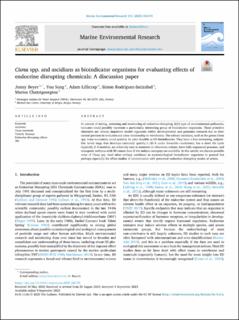| dc.contributor.author | Beyer, Jonny | |
| dc.contributor.author | Song, You | |
| dc.contributor.author | Lillicrap, Adam David | |
| dc.contributor.author | Rodríguez-Satizábal, Simón | |
| dc.contributor.author | Chatzigeorgiou, Marios | |
| dc.date.accessioned | 2023-10-30T14:11:54Z | |
| dc.date.available | 2023-10-30T14:11:54Z | |
| dc.date.created | 2023-09-23T19:15:15Z | |
| dc.date.issued | 2023 | |
| dc.identifier.issn | 0141-1136 | |
| dc.identifier.uri | https://hdl.handle.net/11250/3099488 | |
| dc.description.abstract | In context of testing, screening and monitoring of endocrine-disrupting (ED) type of environmental pollutants, tunicates could possibly represent a particularly interesting group of bioindicator organisms. These primitive chordates are already important model organisms within developmental and genomics research due to their central position in evolution and close relationship to vertebrates. The solitary ascidians, such as the genus Ciona spp. (vase tunicates), could possibly be extra feasible as ED bioindicators. They have a free-swimming, tadpole-like larval stage that develops extremely quickly (<20 h under favorable conditions), has a short life cycle (typically 2–3 months), are relatively easy to maintain in laboratory culture, have fully sequenced genomes, and transgenic embryos with 3D course data of the embryo ontogeny are available. In this article, we discuss possible roles of Ciona spp. (and other solitary ascidians) as ecotoxicological bioindicator organisms in general but perhaps especially for effect studies of contaminants with presumed endocrine disrupting modes of action. | en_US |
| dc.language.iso | eng | en_US |
| dc.publisher | Elsevier | en_US |
| dc.rights | Navngivelse 4.0 Internasjonal | * |
| dc.rights.uri | http://creativecommons.org/licenses/by/4.0/deed.no | * |
| dc.title | Ciona spp. and ascidians as bioindicator organisms for evaluating effects of endocrine disrupting chemicals: A discussion paper | en_US |
| dc.type | Journal article | en_US |
| dc.type | Peer reviewed | en_US |
| dc.description.version | publishedVersion | en_US |
| dc.rights.holder | Copyright 2023 the authors | en_US |
| dc.source.articlenumber | 106170 | en_US |
| cristin.ispublished | true | |
| cristin.fulltext | original | |
| cristin.qualitycode | 1 | |
| dc.identifier.doi | 10.1016/j.marenvres.2023.106170 | |
| dc.identifier.cristin | 2178272 | |
| dc.source.journal | Marine Environmental Research | en_US |
| dc.identifier.citation | Marine Environmental Research. 2023, 191, 106170. | en_US |
| dc.source.volume | 191 | en_US |

